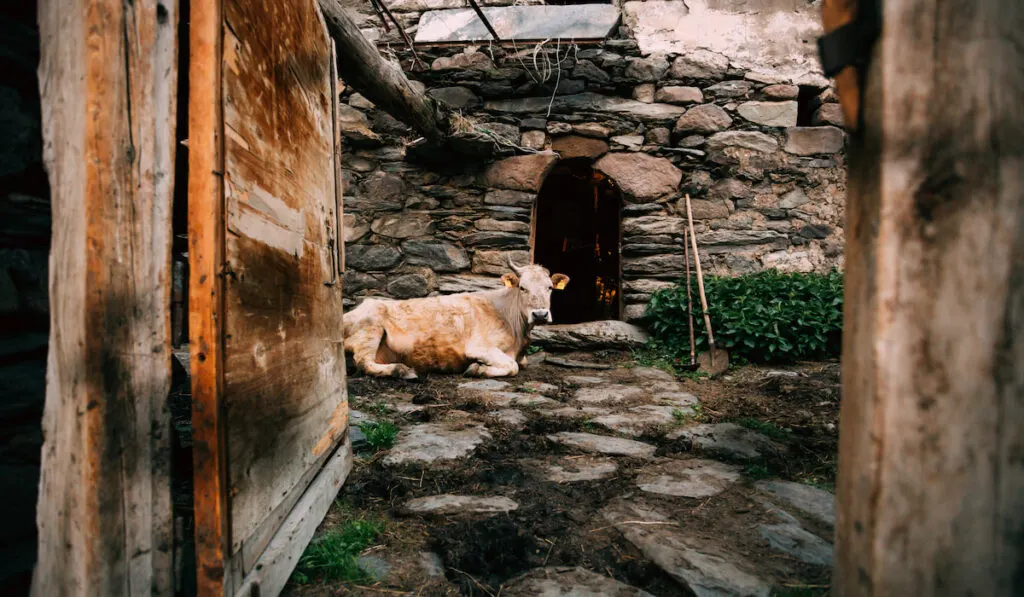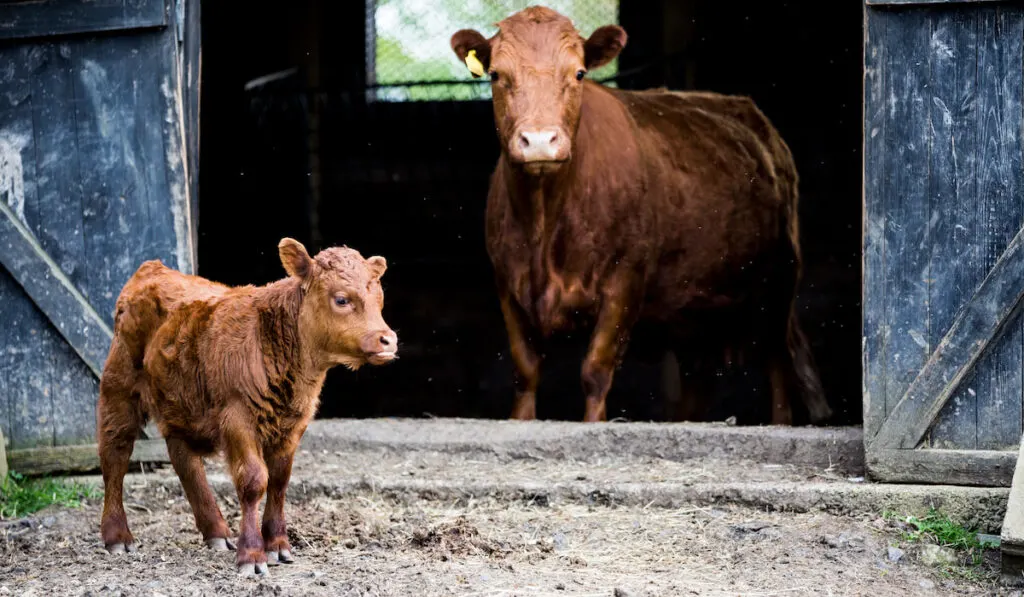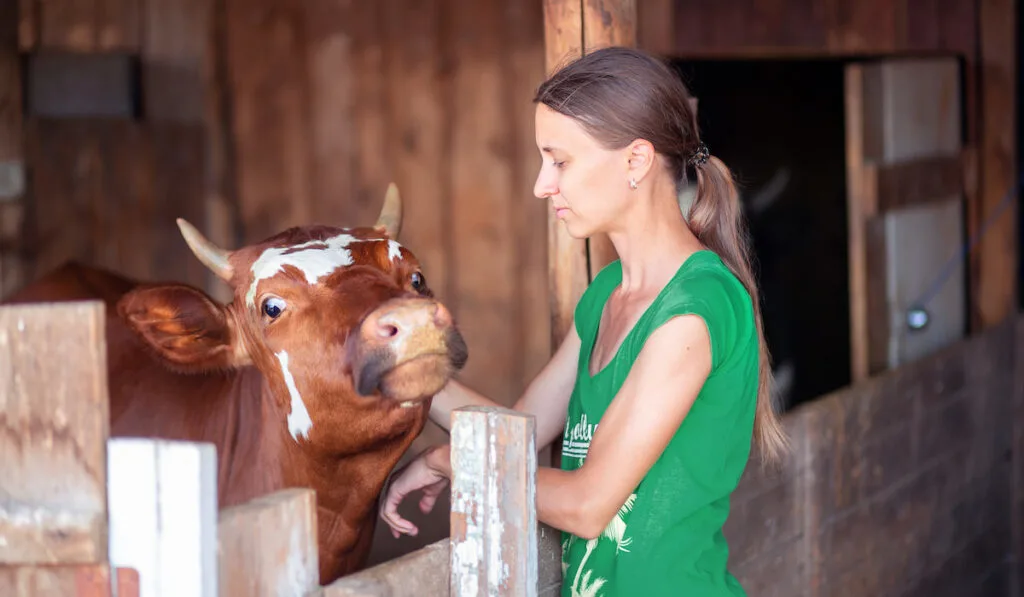It’s a rainy day on your farm, so naturally you run inside your house to take shelter. But you look out the window, and you see your cattle outside, in the rain, unbothered.
Maybe you’re a bit surprised. It’s pouring rain, and you expect the cows to seek shelter from the harsh weather. But they seem to be doing just fine out in the rain.
Do cows need shelter from rain?
The necessity of shelter for cattle when it rains depends on the rain’s intensity and the cattle breed. Cows are generally cold tolerant, but some cattle breeds are more tolerant than others. Since cold is not the only danger that comes with rain, you may have to provide shelter in the presence of other threats.

What do cows do when exposed to the elements? When should you provide shelter for them? Let’s explore how you can be sure to provide the right shelter for your cows.
Table of Contents
Do Cows Need Shelter?
Cows only need shelter very infrequently. There are certain times in their lives when they have to be kept safe from the elements. This is mainly during calving, after calving, and when they are sick.
Cows may shelter underneath trees. But you can also build them a shelter that offers more coverage than a tree.
Do Cows Need Shelter From Rain?
It is not uncommon to find cows standing in the rain. At the same time, you may find them seeking shelter if the rain becomes too intense.
Inclement Weather
Rain itself isn’t dangerous to cows. The other circumstances that come along with the rain and inclement weather may cause a need for extra shelter.
If the rain comes with a storm, your cows will definitely need shelter. Cattle are not resistant to strong winds, thunder, or lightning, so you should not leave them out in a storm.

Extreme Temperatures
Adult cows are normally resistant to cold. You’ll find that they thrive at temperatures ranging from 41-77 °F. Calves, on the other hand, can withstand temperatures between 53.6-77 °F.
Since cows are ruminants, they have digestive bacteria in their gut. The process of digestion by these bacteria is one factor that provides them with internal heat and makes them hardy.
Other than internal heat created by gut bacteria, factors such as breed, fat stores, size, health, diet, and lactation also affect a cow’s resistance to cold temperatures.
However, temperatures can sometimes get too cold for cows, especially when the weather falls below their thermoneutral zone. When this happens, they look for shelter.
Do Cows Need Shelter From Snow?
As the temperature approaches 32 °F during the cold seasons, your cows may start struggling. You may notice this when their productivity falls and when they become less efficient.
You may notice that at extremely low temperatures, your cows may have trouble gaining weight. You may also find that your dairy cows find it hard to lactate.
Cows require shelter not just from snow but during periods of extremely low temperatures. Besides providing shelter, you should ensure the availability of several factors that will ease the effect of the snow on them.
Food
If your cattle are not getting enough food, they are very likely to succumb to the cold weather that comes with snow. Without food, cattle cannot generate internal heat. Their core temperature will fall, and they may end up dead.
To ensure they get enough food, you may opt to get premium feeds with more nutrients than usual. Alternatively, you may keep giving them their usual feed, but make sure they do not waste it.
Water
When it snows, it is also cold enough for most of your cattle’s water sources to become frozen. When this happens, they may not have access to all of the water they need.
The absence of sufficient water leaves cattle at the risk of gut impaction and colic. You need to provide enough water for them to thrive even when the temperature is below freezing.
On average, cattle need 1-2 gallons of water per 100 pounds. You might expect them to get their water by licking ice, but they would expend energy doing this. Since they need all the energy they can get to stay warm, you should give them water they can drink easily.
Bedding
You may also provide your cattle with bedding material. It goes a long way in easing the stress, particularly when your cows are wet. Proper bedding can also help them retain their heat better in colder temperatures.

Do They Need Shelter From Cold?
Cows can thrive in the cold as long as the temperature stays within a specific range. This range is called the thermoneutral zone.
At temperatures below the thermoneutral zone (lower critical temperature), cows will begin to feel cold stress. At such temperatures, they need shelter.
5 Reasons to Provide Shelter for Cows
Ensure Safe Calving
You should provide shelter when your cows are calving in harsh weather conditions. A calving cow should be in optimal condition to ensure that there are no birth complications.
In the presence of extreme cold or extreme heat, cows experience stress. If this happens during calving, there may be complications.
Protect Calves
Calves, especially newborn calves, cannot regulate their body temperature like adult cows. They are at the highest risk during extreme weather conditions. Exposing them to inclement weather may impact their survival.
Help Sick Cows
When a cow is sick, its physiological processes are suboptimal. Cows with preexisting illnesses may not be able to regulate their body temperature properly. Exposing a sick cow to extreme weather (hot or cold) might worsen its symptoms and kill it.
A sick cow should not be kept in poor conditions. You should provide a shelter that meets the requirements for their wellbeing.
In some cases, you may have to isolate a sick cow from other cows in the herd. Having an isolation shelter would come in handy at such times.
Cows with respiratory diseases are particularly vulnerable to extreme weather conditions and should be housed properly.
Prevent Sunburn
If your cows are prone to sunburn, or if they show signs of photosensitivity, you should provide shelter that offers sufficient shade from the sun.
Protect Injured Cows
Cows that have suffered injuries caused by fire or flood are more vulnerable to extreme weather conditions. You should provide shelter that protects them from the elements.

7 Economical Ways to Give Cows Shelter
A cow’s shelter should at the least provide shade from the sun during summer and wind protection in winter.
There are many ways to provide shelter for your cows. You can create an affordable covering or housing with any of the following options:
- Shade Cloth Shed
- Corrugated Iron Shed
- Corrugated Timber Shed
- Large Canopy Trees
- Shelterbelts
- Constructed Windbreaks
- Remodeled Post Frame Building
Conclusion
While cows might sometimes stand in the rain, you should have a shelter available in case they need to take cover. Cows are hardy, but harsh weather and extreme temperatures can be dangerous. Providing shelter for your healthy and sick cows will promote their overall wellness.
Resources
- https://www.nutrenaworld.com/blog/shelter-care-basics-for-cattle
- https://www.backyardherds.com/threads/why-do-cattle-opt-to-stand-out-in-a-pouring-cold-rain.16221/
- https://proearthanimalhealth.com/how-weather-affects-your-cattle-and-horses-stress/#
- http://www.omafra.gov.on.ca/english/livestock/beef/facts/07-001.htm
- https://www.zarebasystems.com/articles/cold-weather-tips-for-cattle
- https://agriculture.vic.gov.au/livestock-and-animals/dairy/health-and-welfare/cattle-shelter-guidelines
